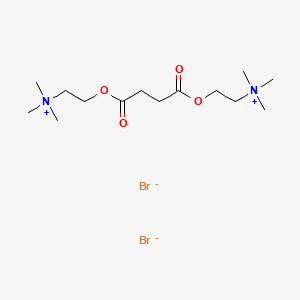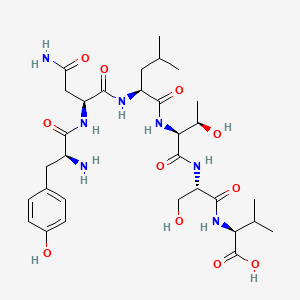
Sulfadiazine
Vue d'ensemble
Description
Sulfadiazine est un antibiotique sulfamidé largement utilisé dans le traitement de diverses infections bactériennes. Il est particulièrement efficace contre les infections urinaires, le trachome et le chancre mou . La this compound est également utilisée en association avec la pyriméthamine pour traiter la toxoplasmose chez les patients atteints du syndrome d'immunodéficience acquise et chez les nouveau-nés atteints d'infections congénitales . Ce composé est connu pour sa capacité à inhiber la synthèse de l'acide folique dans les bactéries, empêchant ainsi leur croissance et leur prolifération .
Applications De Recherche Scientifique
Sulfadiazine has a wide range of scientific research applications:
Mécanisme D'action
Target of Action
Sulfadiazine primarily targets the bacterial enzyme dihydropteroate synthetase . This enzyme plays a crucial role in the synthesis of folic acid, which is essential for bacterial growth and reproduction .
Mode of Action
This compound acts as a competitive inhibitor of dihydropteroate synthetase . It competes with para-aminobenzoic acid (PABA) for binding to the enzyme, thereby inhibiting the synthesis of folic acid . This results in the inhibition of bacterial growth and reproduction .
Biochemical Pathways
The primary biochemical pathway affected by this compound is the folic acid synthesis pathway in bacteria . By inhibiting dihydropteroate synthetase, this compound prevents the proper processing of PABA, which is essential for folic acid synthesis . This leads to a decrease in the production of folic acid, which is necessary for bacterial growth and reproduction .
Pharmacokinetics
This compound is rapidly and extensively absorbed from the gut and is 20 to 55% bound to plasma proteins . Its elimination half-life is 7-12 hours . This compound can cross the placenta, achieving blood concentrations in the fetus of 50 to 90% of those in the mother . It also achieves high concentrations in breast milk (20% of plasma) .
Result of Action
The primary result of this compound’s action is the inhibition of bacterial growth and reproduction . By inhibiting the synthesis of folic acid, this compound prevents bacteria from growing and reproducing effectively . This makes it an effective treatment for a variety of bacterial infections .
Action Environment
The action of this compound can be influenced by various environmental factors. For example, the presence of pus can inhibit its antibacterial action . The degradation of this compound can be influenced by factors such as temperature, pH, and the presence of certain ions .
Méthodes De Préparation
Voies de synthèse et conditions de réaction
La synthèse de la sulfadiazine commence généralement par l'acétylation de dérivés de l'aniline à l'aide d'anhydride acétique pour former des dérivés de l'acétanilide . Ces dérivés sont ensuite mis à réagir avec l'acide chlorosulfonique pour produire du chlorure de 4-acétylaminobenzènesulfonyle . En parallèle, la 2-aminopyrimidine est préparée en faisant réagir le tétraméthoxypropane avec un sel de guanidine . L'étape finale consiste à faire réagir le chlorure de 4-acétylaminobenzènesulfonyle avec la 2-aminopyrimidine, suivie d'une hydrolyse avec de l'hydroxyde de sodium pour obtenir la this compound .
Méthodes de production industrielle
La production industrielle de la this compound suit des voies de synthèse similaires, mais à plus grande échelle. Le processus implique un contrôle strict des conditions de réaction pour garantir un rendement élevé et une pureté optimale. L'utilisation de réacteurs automatisés et de systèmes à flux continu contribue à maintenir une qualité et une efficacité constantes dans la production .
Analyse Des Réactions Chimiques
Types de réactions
La sulfadiazine subit diverses réactions chimiques, notamment l'oxydation, la réduction et la substitution . Le composé contient deux groupes réactifs : une amine aromatique et un groupe sulfonamide, qui participent à ces réactions .
Réactifs et conditions courants
Oxydation : La this compound peut être oxydée à l'aide de réactifs comme le peroxyde d'hydrogène et le persulfate en milieu acide.
Réduction : La réduction de la this compound peut être obtenue à l'aide d'agents réducteurs comme le borohydrure de sodium.
Substitution : Le groupe amine aromatique de la this compound peut subir des réactions de substitution avec des électrophiles en présence de catalyseurs.
Principaux produits
Les principaux produits formés par ces réactions comprennent divers dérivés de la this compound, qui peuvent être utilisés dans des applications pharmaceutiques .
Applications de la recherche scientifique
La this compound a un large éventail d'applications de recherche scientifique :
Chimie : Utilisée comme réactif dans la synthèse d'autres dérivés de la sulfamide.
Biologie : Employée dans des études portant sur la résistance bactérienne et le développement de nouveaux antibiotiques.
Industrie : Appliquée dans la production de médicaments vétérinaires et comme conservateur dans certaines formulations.
Mécanisme d'action
La this compound agit en inhibant l'enzyme bactérienne dihydroptéroate synthétase . Cette enzyme est essentielle à la synthèse de l'acide folique, qui est indispensable à la croissance et à la réplication bactériennes . En inhibant de manière compétitive cette enzyme, la this compound empêche les bactéries de synthétiser l'acide folique, ce qui entraîne leur mort éventuelle .
Comparaison Avec Des Composés Similaires
Composés similaires
Sulfaméthoxazole : Un autre antibiotique sulfamidé utilisé en association avec le triméthoprime pour traiter diverses infections bactériennes.
Sulfisoxazole : Utilisé pour traiter les infections des voies urinaires et d'autres infections bactériennes.
Sulfamidine d'argent : Un agent topique utilisé dans le traitement des brûlures et des infections des plaies.
Unicité
La sulfadiazine est unique en raison de son activité antibactérienne à large spectre et de sa capacité à être utilisée en association avec d'autres médicaments comme la pyriméthamine pour le traitement d'infections spécifiques comme la toxoplasmose . Son efficacité en médecine humaine et vétérinaire souligne sa polyvalence .
Propriétés
IUPAC Name |
4-amino-N-pyrimidin-2-ylbenzenesulfonamide | |
|---|---|---|
| Source | PubChem | |
| URL | https://pubchem.ncbi.nlm.nih.gov | |
| Description | Data deposited in or computed by PubChem | |
InChI |
InChI=1S/C10H10N4O2S/c11-8-2-4-9(5-3-8)17(15,16)14-10-12-6-1-7-13-10/h1-7H,11H2,(H,12,13,14) | |
| Source | PubChem | |
| URL | https://pubchem.ncbi.nlm.nih.gov | |
| Description | Data deposited in or computed by PubChem | |
InChI Key |
SEEPANYCNGTZFQ-UHFFFAOYSA-N | |
| Source | PubChem | |
| URL | https://pubchem.ncbi.nlm.nih.gov | |
| Description | Data deposited in or computed by PubChem | |
Canonical SMILES |
C1=CN=C(N=C1)NS(=O)(=O)C2=CC=C(C=C2)N | |
| Source | PubChem | |
| URL | https://pubchem.ncbi.nlm.nih.gov | |
| Description | Data deposited in or computed by PubChem | |
Molecular Formula |
C10H10N4O2S | |
| Source | PubChem | |
| URL | https://pubchem.ncbi.nlm.nih.gov | |
| Description | Data deposited in or computed by PubChem | |
DSSTOX Substance ID |
DTXSID7044130 | |
| Record name | Sulfadiazine | |
| Source | EPA DSSTox | |
| URL | https://comptox.epa.gov/dashboard/DTXSID7044130 | |
| Description | DSSTox provides a high quality public chemistry resource for supporting improved predictive toxicology. | |
Molecular Weight |
250.28 g/mol | |
| Source | PubChem | |
| URL | https://pubchem.ncbi.nlm.nih.gov | |
| Description | Data deposited in or computed by PubChem | |
Physical Description |
Solid | |
| Record name | Sulfadiazine | |
| Source | Human Metabolome Database (HMDB) | |
| URL | http://www.hmdb.ca/metabolites/HMDB0014503 | |
| Description | The Human Metabolome Database (HMDB) is a freely available electronic database containing detailed information about small molecule metabolites found in the human body. | |
| Explanation | HMDB is offered to the public as a freely available resource. Use and re-distribution of the data, in whole or in part, for commercial purposes requires explicit permission of the authors and explicit acknowledgment of the source material (HMDB) and the original publication (see the HMDB citing page). We ask that users who download significant portions of the database cite the HMDB paper in any resulting publications. | |
Solubility |
6.01e-01 g/L | |
| Record name | Sulfadiazine | |
| Source | DrugBank | |
| URL | https://www.drugbank.ca/drugs/DB00359 | |
| Description | The DrugBank database is a unique bioinformatics and cheminformatics resource that combines detailed drug (i.e. chemical, pharmacological and pharmaceutical) data with comprehensive drug target (i.e. sequence, structure, and pathway) information. | |
| Explanation | Creative Common's Attribution-NonCommercial 4.0 International License (http://creativecommons.org/licenses/by-nc/4.0/legalcode) | |
| Record name | Sulfadiazine | |
| Source | Human Metabolome Database (HMDB) | |
| URL | http://www.hmdb.ca/metabolites/HMDB0014503 | |
| Description | The Human Metabolome Database (HMDB) is a freely available electronic database containing detailed information about small molecule metabolites found in the human body. | |
| Explanation | HMDB is offered to the public as a freely available resource. Use and re-distribution of the data, in whole or in part, for commercial purposes requires explicit permission of the authors and explicit acknowledgment of the source material (HMDB) and the original publication (see the HMDB citing page). We ask that users who download significant portions of the database cite the HMDB paper in any resulting publications. | |
Mechanism of Action |
Sulfadiazine is a competitive inhibitor of the bacterial enzyme dihydropteroate synthetase. This enzyme is needed for the proper processing of para-aminobenzoic acid (PABA) which is essential for folic acid synthesis. The inhibited reaction is necessary in these organisms for the synthesis of folic acid. | |
| Record name | Sulfadiazine | |
| Source | DrugBank | |
| URL | https://www.drugbank.ca/drugs/DB00359 | |
| Description | The DrugBank database is a unique bioinformatics and cheminformatics resource that combines detailed drug (i.e. chemical, pharmacological and pharmaceutical) data with comprehensive drug target (i.e. sequence, structure, and pathway) information. | |
| Explanation | Creative Common's Attribution-NonCommercial 4.0 International License (http://creativecommons.org/licenses/by-nc/4.0/legalcode) | |
CAS No. |
68-35-9 | |
| Record name | Sulfadiazine | |
| Source | CAS Common Chemistry | |
| URL | https://commonchemistry.cas.org/detail?cas_rn=68-35-9 | |
| Description | CAS Common Chemistry is an open community resource for accessing chemical information. Nearly 500,000 chemical substances from CAS REGISTRY cover areas of community interest, including common and frequently regulated chemicals, and those relevant to high school and undergraduate chemistry classes. This chemical information, curated by our expert scientists, is provided in alignment with our mission as a division of the American Chemical Society. | |
| Explanation | The data from CAS Common Chemistry is provided under a CC-BY-NC 4.0 license, unless otherwise stated. | |
| Record name | Sulfadiazine [USP:INN:BAN:JAN] | |
| Source | ChemIDplus | |
| URL | https://pubchem.ncbi.nlm.nih.gov/substance/?source=chemidplus&sourceid=0000068359 | |
| Description | ChemIDplus is a free, web search system that provides access to the structure and nomenclature authority files used for the identification of chemical substances cited in National Library of Medicine (NLM) databases, including the TOXNET system. | |
| Record name | Sulfadiazine | |
| Source | DrugBank | |
| URL | https://www.drugbank.ca/drugs/DB00359 | |
| Description | The DrugBank database is a unique bioinformatics and cheminformatics resource that combines detailed drug (i.e. chemical, pharmacological and pharmaceutical) data with comprehensive drug target (i.e. sequence, structure, and pathway) information. | |
| Explanation | Creative Common's Attribution-NonCommercial 4.0 International License (http://creativecommons.org/licenses/by-nc/4.0/legalcode) | |
| Record name | sulfadiazine | |
| Source | DTP/NCI | |
| URL | https://dtp.cancer.gov/dtpstandard/servlet/dwindex?searchtype=NSC&outputformat=html&searchlist=757324 | |
| Description | The NCI Development Therapeutics Program (DTP) provides services and resources to the academic and private-sector research communities worldwide to facilitate the discovery and development of new cancer therapeutic agents. | |
| Explanation | Unless otherwise indicated, all text within NCI products is free of copyright and may be reused without our permission. Credit the National Cancer Institute as the source. | |
| Record name | sulfadiazine | |
| Source | DTP/NCI | |
| URL | https://dtp.cancer.gov/dtpstandard/servlet/dwindex?searchtype=NSC&outputformat=html&searchlist=35600 | |
| Description | The NCI Development Therapeutics Program (DTP) provides services and resources to the academic and private-sector research communities worldwide to facilitate the discovery and development of new cancer therapeutic agents. | |
| Explanation | Unless otherwise indicated, all text within NCI products is free of copyright and may be reused without our permission. Credit the National Cancer Institute as the source. | |
| Record name | Benzenesulfonamide, 4-amino-N-2-pyrimidinyl- | |
| Source | EPA Chemicals under the TSCA | |
| URL | https://www.epa.gov/chemicals-under-tsca | |
| Description | EPA Chemicals under the Toxic Substances Control Act (TSCA) collection contains information on chemicals and their regulations under TSCA, including non-confidential content from the TSCA Chemical Substance Inventory and Chemical Data Reporting. | |
| Record name | Sulfadiazine | |
| Source | EPA DSSTox | |
| URL | https://comptox.epa.gov/dashboard/DTXSID7044130 | |
| Description | DSSTox provides a high quality public chemistry resource for supporting improved predictive toxicology. | |
| Record name | Sulfadiazine | |
| Source | European Chemicals Agency (ECHA) | |
| URL | https://echa.europa.eu/substance-information/-/substanceinfo/100.000.623 | |
| Description | The European Chemicals Agency (ECHA) is an agency of the European Union which is the driving force among regulatory authorities in implementing the EU's groundbreaking chemicals legislation for the benefit of human health and the environment as well as for innovation and competitiveness. | |
| Explanation | Use of the information, documents and data from the ECHA website is subject to the terms and conditions of this Legal Notice, and subject to other binding limitations provided for under applicable law, the information, documents and data made available on the ECHA website may be reproduced, distributed and/or used, totally or in part, for non-commercial purposes provided that ECHA is acknowledged as the source: "Source: European Chemicals Agency, http://echa.europa.eu/". Such acknowledgement must be included in each copy of the material. ECHA permits and encourages organisations and individuals to create links to the ECHA website under the following cumulative conditions: Links can only be made to webpages that provide a link to the Legal Notice page. | |
| Record name | SULFADIAZINE | |
| Source | FDA Global Substance Registration System (GSRS) | |
| URL | https://gsrs.ncats.nih.gov/ginas/app/beta/substances/0N7609K889 | |
| Description | The FDA Global Substance Registration System (GSRS) enables the efficient and accurate exchange of information on what substances are in regulated products. Instead of relying on names, which vary across regulatory domains, countries, and regions, the GSRS knowledge base makes it possible for substances to be defined by standardized, scientific descriptions. | |
| Explanation | Unless otherwise noted, the contents of the FDA website (www.fda.gov), both text and graphics, are not copyrighted. They are in the public domain and may be republished, reprinted and otherwise used freely by anyone without the need to obtain permission from FDA. Credit to the U.S. Food and Drug Administration as the source is appreciated but not required. | |
| Record name | Sulfadiazine | |
| Source | Human Metabolome Database (HMDB) | |
| URL | http://www.hmdb.ca/metabolites/HMDB0014503 | |
| Description | The Human Metabolome Database (HMDB) is a freely available electronic database containing detailed information about small molecule metabolites found in the human body. | |
| Explanation | HMDB is offered to the public as a freely available resource. Use and re-distribution of the data, in whole or in part, for commercial purposes requires explicit permission of the authors and explicit acknowledgment of the source material (HMDB) and the original publication (see the HMDB citing page). We ask that users who download significant portions of the database cite the HMDB paper in any resulting publications. | |
Synthesis routes and methods
Procedure details





Retrosynthesis Analysis
AI-Powered Synthesis Planning: Our tool employs the Template_relevance Pistachio, Template_relevance Bkms_metabolic, Template_relevance Pistachio_ringbreaker, Template_relevance Reaxys, Template_relevance Reaxys_biocatalysis model, leveraging a vast database of chemical reactions to predict feasible synthetic routes.
One-Step Synthesis Focus: Specifically designed for one-step synthesis, it provides concise and direct routes for your target compounds, streamlining the synthesis process.
Accurate Predictions: Utilizing the extensive PISTACHIO, BKMS_METABOLIC, PISTACHIO_RINGBREAKER, REAXYS, REAXYS_BIOCATALYSIS database, our tool offers high-accuracy predictions, reflecting the latest in chemical research and data.
Strategy Settings
| Precursor scoring | Relevance Heuristic |
|---|---|
| Min. plausibility | 0.01 |
| Model | Template_relevance |
| Template Set | Pistachio/Bkms_metabolic/Pistachio_ringbreaker/Reaxys/Reaxys_biocatalysis |
| Top-N result to add to graph | 6 |
Feasible Synthetic Routes
Avertissement et informations sur les produits de recherche in vitro
Veuillez noter que tous les articles et informations sur les produits présentés sur BenchChem sont destinés uniquement à des fins informatives. Les produits disponibles à l'achat sur BenchChem sont spécifiquement conçus pour des études in vitro, qui sont réalisées en dehors des organismes vivants. Les études in vitro, dérivées du terme latin "in verre", impliquent des expériences réalisées dans des environnements de laboratoire contrôlés à l'aide de cellules ou de tissus. Il est important de noter que ces produits ne sont pas classés comme médicaments et n'ont pas reçu l'approbation de la FDA pour la prévention, le traitement ou la guérison de toute condition médicale, affection ou maladie. Nous devons souligner que toute forme d'introduction corporelle de ces produits chez les humains ou les animaux est strictement interdite par la loi. Il est essentiel de respecter ces directives pour assurer la conformité aux normes légales et éthiques en matière de recherche et d'expérimentation.







![(2S,3S)-2-(dimethylamino)-N-[(2S)-2-[[(3R,5S)-3-methoxy-1-[(2S)-2-[(2R)-1-methoxy-2-methyl-3-oxo-3-[[(1R)-2-phenyl-1-(1,3-thiazol-2-yl)ethyl]amino]propyl]pyrrolidin-1-yl]-5-methyl-1-oxoheptan-4-yl]-methylamino]-3-methylbutanoyl]-3-methylpentanamide](/img/structure/B1682575.png)



![Propan-2-yl 3-[[benzyl(methyl)amino]methyl]-7-[(2,6-difluorophenyl)methyl]-2-[4-(2-methylpropanoylamino)phenyl]-4-oxothieno[2,3-b]pyridine-5-carboxylate](/img/structure/B1682580.png)



